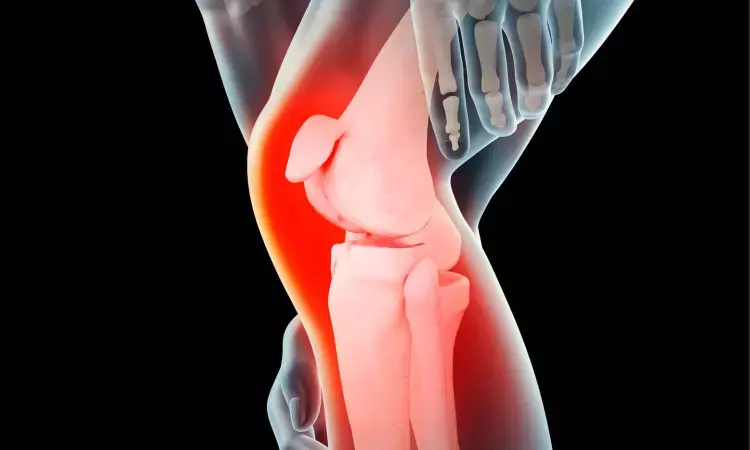- Home
- Medical news & Guidelines
- Anesthesiology
- Cardiology and CTVS
- Critical Care
- Dentistry
- Dermatology
- Diabetes and Endocrinology
- ENT
- Gastroenterology
- Medicine
- Nephrology
- Neurology
- Obstretics-Gynaecology
- Oncology
- Ophthalmology
- Orthopaedics
- Pediatrics-Neonatology
- Psychiatry
- Pulmonology
- Radiology
- Surgery
- Urology
- Laboratory Medicine
- Diet
- Nursing
- Paramedical
- Physiotherapy
- Health news
- Fact Check
- Bone Health Fact Check
- Brain Health Fact Check
- Cancer Related Fact Check
- Child Care Fact Check
- Dental and oral health fact check
- Diabetes and metabolic health fact check
- Diet and Nutrition Fact Check
- Eye and ENT Care Fact Check
- Fitness fact check
- Gut health fact check
- Heart health fact check
- Kidney health fact check
- Medical education fact check
- Men's health fact check
- Respiratory fact check
- Skin and hair care fact check
- Vaccine and Immunization fact check
- Women's health fact check
- AYUSH
- State News
- Andaman and Nicobar Islands
- Andhra Pradesh
- Arunachal Pradesh
- Assam
- Bihar
- Chandigarh
- Chattisgarh
- Dadra and Nagar Haveli
- Daman and Diu
- Delhi
- Goa
- Gujarat
- Haryana
- Himachal Pradesh
- Jammu & Kashmir
- Jharkhand
- Karnataka
- Kerala
- Ladakh
- Lakshadweep
- Madhya Pradesh
- Maharashtra
- Manipur
- Meghalaya
- Mizoram
- Nagaland
- Odisha
- Puducherry
- Punjab
- Rajasthan
- Sikkim
- Tamil Nadu
- Telangana
- Tripura
- Uttar Pradesh
- Uttrakhand
- West Bengal
- Medical Education
- Industry
Study reports good long-term outcomes following robotic-assisted medial knee arthroplasty

USA: Researchers find high 10-year implant survival and patient satisfaction (exceeding 90%) following robotic-arm-assisted unicompartmental knee arthroplasty (UKA) at ten years' follow-up in a prospective multicenter study published in The Journal of Bone & Joint Surgery.
The study led by Tarik Bayoumi, MD, of the Hospital for Special Surgery, Weill Medical College of Cornell University, New York, also revealed pain and fixation failure to be the common causes for revision after cemented fixed-bearing medial UKA, despite using a robotic-arm-assisted technique.
First data on long-term outcomes of robot-assisted UKA
In UKA, just one of three compartments of the knee-the medial compartment is replaced with a prosthesis. Because it preserves most of the normal knee anatomy, UKA may offer a shorter hospital stay and greater knee range of motion postoperatively compared with the more common and extensive total knee arthroplasty (TKA).
Previous studies have shown that the use of a surgeon-controlled robotic arm can improve the precision of UKA, potentially avoiding technical errors that can affect outcomes postoperatively. Previous studies have reported high survivorship free from conversion to TKA at mid-term follow-up following robotic-arm assisted UKA. "Given the increased use of robotic systems in knee arthroplasty and the favorable early outcomes, the current challenge lies in demonstrating whether these results can be maintained at longer-term follow-up," the researchers write.
In their prospective study, Dr. Bayoumi and colleagues analyzed the 10-year outcomes of 411 knees in 366 patients undergoing robotic-arm assisted medial UKA at four participating centers. Fifty-seven percent of patients were male, and the average age at surgery was 67.2 years.
All procedures were performed by four experienced knee arthroplasty surgeons who received special training and practice in robotic-arm-assisted UKA. The study included 10-year follow-up data on the initial series of patients who received a specific type of cemented implant (Restoris MCK System) and a third-generation robotic-guided surgical system (Mako Robotic-Arm Assisted System).
Ten years later, high satisfaction rates and freedom from TKA
Follow-up results showed good outcomes of robotic-assisted UKA. Overall survivorship with the medial UKA implant still in place was 91.7%. Of the 29 revisions, 26 were a conversion to TKA, for a survivorship of 92.6%.
The rate of conversion to TKA was about twice as high in women compared to men: hazard ratio of 2.3. Revision risk was also higher for patients with a body mass index of 30 kg/m2 or higher; and for younger patients, likely reflecting a more active lifestyle and increased demands on the knee. Most revision surgeries resulted from unexplained knee pain or aseptic loosening.
Patient satisfaction ratings supported the good outcomes of robotic-assisted UKA. "Of all patients without revision, 91% reported being either very satisfied or satisfied with their operative knee, while 4% were dissatisfied or very dissatisfied," the researchers write.
The high rates of survivorship and patient satisfaction are consistent with long-term studies of conventional UKA. The researchers note some limitations of their study, highlighting the need for prospective comparative studies. Dr. Bayoumi comments, "Since this was a single-arm trial, it remains to be determined whether robotic-arm assistance for UKA results in improved outcomes compared to conventional UKA."
Reference:
Tarik Bayoumi, Laura J. Kleeblad, Todd A. Borus, Thomas M. Coon, Jon Dounchis, Joseph T. Nguyen, Andrew D. Pearle, The Journal of Bone and Joint Surgery, DOI: 10.2106/JBJS.22.01104.
Dr Kamal Kant Kohli-MBBS, DTCD- a chest specialist with more than 30 years of practice and a flair for writing clinical articles, Dr Kamal Kant Kohli joined Medical Dialogues as a Chief Editor of Medical News. Besides writing articles, as an editor, he proofreads and verifies all the medical content published on Medical Dialogues including those coming from journals, studies,medical conferences,guidelines etc. Email: drkohli@medicaldialogues.in. Contact no. 011-43720751


